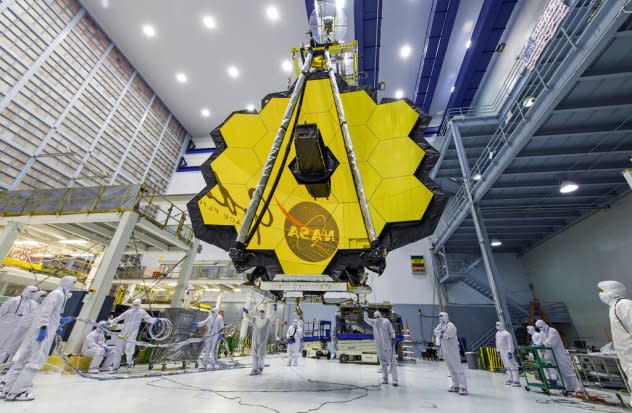NASA's brand new $10 billion telescope hit by space rock
The most powerful telescope ever launched into space was recently damaged by a small space rock hurtling through the solar system.
NASA made the announcement Wednesday, stating that the collision with the James Webb Space Telescope occurred between May 23 and May 25, adding that micrometeoroid strikes such as this are "unavoidable."
The dust-sized micrometeoroid hit one of the most crucial pieces of the telescope, one of the 18 gold-plated mirrors that gather light from the depths of the universe and reflect that light toward an instrument that collects the light.
"We always knew that Webb would have to weather the space environment," said Paul Geithner, the technical deputy project manager at NASA's Goddard Space Flight Center.
 |
This 2015 artist's rendering provided by Northrop Grumman via NASA shows the James Webb Space Telescope. (Northrop Grumman/NASA via AP) |
The James Webb Space Telescope, which cost roughly $10 billion, was launched Saturday, Dec. 25, 2021, and is not yet fully operational.
Despite the dinged mirror, scientists say that the telescope can still operate at full capacity.
"We designed and built Webb with performance margin - optical, thermal, electrical, mechanical - to ensure it can perform its ambitious science mission even after many years in space," Geithner said.
An initial assessment found that the performance of the instruments still exceeds all mission requirements even with the cosmetic damage.
Have the app? Unlock AccuWeather Alerts™ with Premium+
Flight teams on Earth have the ability to maneuver Webb to protect crucial instruments from well-known streams of debris, such as a meteor shower, but that was not the case with the late-May collision.
"This most recent hit was not a result of a meteor shower and is currently considered an unavoidable chance event," NASA said in a press release.
Scientists say that the recent impact will not change the team's operation schedule with the first full-color images from Webb scheduled to be released on July 12. This highly-anticipated image is expected to be better than a test photo that the telescope captured in March of a star 2,000 light-years away from Earth while scientists were calibrating its mirrors.
 |
In this April 13, 2017 photo provided by NASA, technicians lift the mirror of the James Webb Space Telescope using a crane at the Goddard Space Flight Center in Greenbelt, Md. (Laura Betz/NASA via AP, File) |
Webb was built as a successor to the decades-old Hubble Space Telescope, which was sent into space on April 24, 1990.
The primary mirror of the newer telescope is 21 feet across, significantly larger than Hubble's primary mirror which is 7.9 feet across. This allows Webb to collect more light and get a better view of distant objects that Hubble may not even be able to detect.
However, unlike the Hubble, which orbits the Earth, Webb is floating at a special spot in space known as a Lagrange point nearly 1 million miles away from the planet. Being at this distance makes it virtually impossible for a crew to be sent into space to fix the telescope if technical issues or damage occur.
Want next-level safety, ad-free? Unlock advanced, hyperlocal severe weather alerts when you subscribe to Premium+ on the AccuWeather app. AccuWeather Alerts™ are prompted by our expert meteorologists who monitor and analyze dangerous weather risks 24/7 to keep you and your family safer.


